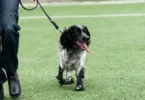Welcome to our comprehensive guide on resolving common dog behavior problems. At petscareworld.com, we understand that owning a dog comes with its fair share of challenges. From housebreaking issues to excessive barking, we’ve got you covered. In this article, we will address various dog behavior problems and provide effective solutions to help you create a harmonious and well-behaved canine companion.
1. Understanding Dog Behavior Problems
Dogs, like humans, can exhibit a range of behavior issues that stem from various factors. Understanding the underlying causes is crucial in finding effective solutions. Some common causes include lack of training, fear, anxiety, boredom, or medical conditions. By identifying the root cause, you can address the problem more effectively.
2. Housebreaking Challenges and Solutions – Dog Behavior Problems
Housebreaking is often one of the first challenges dog owners face. Whether you have a new puppy or an adult dog, accidents can happen. Here are some key steps to successfully housebreak your dog:
- Establish a routine: Set a consistent schedule for feeding, bathroom breaks, and exercise.
- Positive reinforcement: Reward your dog for eliminating in the appropriate area.
- Consistency and supervision: Keep a close eye on your dog, especially during the training phase.
- Patience and persistence: Housebreaking takes time, so be patient and consistent in your approach.
3. Excessive Barking: Causes and Remedies of Dog Behavior Problems
Excessive barking can be disruptive and frustrating for both you and your neighbors. Here’s how you can address this issue:
- Identify the trigger: Determine what causes your dog to bark excessively, such as boredom, fear, or territorial behavior.
- Positive redirection: Use positive reinforcement techniques to redirect their attention and reward calm behavior.
- Environmental management: Minimize triggers and provide distractions, such as toys or puzzles, to keep your dog mentally stimulated.
- Professional help: If the barking persists, consult with a professional dog trainer or behaviorist for further guidance.
Causes of Dog Excessive Barking: Dog Behavior Problems
- Loneliness and Boredom
- Lack of companionship or mental stimulation.
- Solution: Provide interactive toys, rotate them regularly, and spend quality time with your dog.
- Territorial Behavior
- Protecting their environment from perceived threats.
- Solution: Train your dog to respond to the “quiet” command and use positive reinforcement.
- Attention-Seeking
- Barking to gain your attention or a desired response.
- Solution: Ignore barking and reward quiet behavior to discourage attention-seeking.
- Fear and Anxiety
- Barking in response to unfamiliar or stressful situations.
- Solution: Gradual exposure to triggers and positive reinforcement for calm behavior.
- Excess Energy
- Pent-up energy from lack of physical activity.
- Solution: Regular exercise, playtime, and mental stimulation through games and training.
Remedies for Dog Excessive Barking: Dog Behavior Problems
- Positive Reinforcement Training
- Reward quiet behavior with treats, praise, or toys.
- Use clicker training to mark and reinforce silence.
- Environmental Enrichment
- Provide engaging toys, puzzle feeders, and activities to keep your dog mentally stimulated.
- Desensitization
- Introduce your dog to triggers in a controlled manner, rewarding calm responses.
- Establishing a Routine
- Create a consistent daily schedule that includes exercise, feeding, and playtime.
- Socialization
- Expose your dog to different people, animals, and environments to reduce fear-based barking.
- Professional Guidance
- Consult a professional dog trainer or behaviorist for tailored strategies.
- In severe cases, medication or specialized training may be recommended.
- Anti-Barking Devices
- Collars or devices that emit a gentle spray, sound, or vibration to interrupt barking.
- Create “Quiet” Zones
- Designate specific areas where barking is not allowed to encourage quiet behavior.
Remember, excessive barking is a natural way for dogs to communicate, but it can be managed effectively through understanding and consistent training. By identifying the root causes and applying appropriate remedies, you can help your dog develop better barking habits. Create a more peaceful environment for both of you.
4. Dog Aggression Issues: Dog Behavior Problems
Aggression in dogs can be a serious problem that requires professional guidance. However, there are steps you can take to manage reactive behavior:
- Identify triggers: Determine what situations or stimuli provoke aggression in your dog.
- Counter-conditioning: Gradually expose your dog to the triggers while rewarding calm and non-reactive behavior.
- Positive reinforcement training: Utilize reward-based training methods to teach your dog alternative behaviors.
- Seek professional assistance: Consult with a certified dog behaviorist to develop a customized behavior modification plan.
5. Dog Separation Anxiety: Alleviating Distress
Separation anxiety is a common issue that many dogs experience when left alone. Here are some strategies to help alleviate separation anxiety:
- Gradual departures: Start with short periods of separation and gradually increase the duration.
- Create a safe space: Provide a comfortable and secure area for your dog, such as a crate or designated room.
- Mental and physical stimulation: Engage your dog in interactive toys or puzzles to keep them occupied in your absence.
- Desensitization techniques: Practice leaving and returning without making a big fuss, gradually reducing the anxiety associated with departures.
6. Destructive Chewing: Redirecting the Dog Behavior Problems
Destructive chewing can be frustrating and damaging to your belongings. Here’s how to address this issue:
- Provide appropriate chew toys: Offer a variety of safe and durable chew toys to redirect your dog’s chewing behavior.
- Environmental management: Limit access to areas with valuable items or use baby gates to restrict access.
- Supervision and redirection: Keep a close eye on your dog and redirect its attention to the appropriate chew toys.
- Proper exercise: Ensure your dog receives sufficient physical and mental exercise to help alleviate boredom and destructive tendencies.
7. Leash Pulling: Teaching Dog Loose Leash Walking
Leash pulling can make walks less enjoyable and potentially dangerous. To teach your dog loose leash walking:
- Use proper equipment: Choose a suitable harness or collar that provides better control and reduces strain on the neck.
- Reward-based training: Use positive reinforcement to reward your dog for walking calmly beside you.
- Start with short walks: Begin training in a low-distraction environment and gradually progress to busier areas.
- Consistency and practice: Be patient and consistent in your training efforts, practicing loose leash walking regularly.
8. Jumping Up: Encouraging Polite Greetings
Jumping up on people is a common dog behavior problem that can be addressed with these techniques:
- Ignore the behavior: Avoid giving attention or physical contact when your dog jumps up.
- Reward alternative behaviors: Teach your dog to sit or offer a paw as an alternative greeting behavior.
- Consistency among family members: Ensure everyone in the household follows the same rules to avoid confusion.
- Seek professional guidance: If the jumping behavior persists, consult with a professional trainer for additional assistance.
9. Resource Guarding: Overcoming Possessiveness
Resource guarding occurs when a dog becomes possessive over food, toys, or other items. Here’s how to address this behavior:
- Prevention and management: Avoid triggering situations and keep valuable resources out of reach during training.
- Counter-conditioning: Teach your dog that giving up possessions results in rewards and positive experiences.
- Professional assistance: Consult with a qualified behaviorist who can provide guidance tailored to your dog’s specific needs.
10. Dog Behavior Problem: Handling Fear and Phobias
Fear and phobias can significantly impact a dog’s behavior. Here are some strategies to help your dog overcome fear and build confidence:
- Gradual desensitization: Introduce your dog to fear-inducing stimuli in a controlled and positive manner.
- Counter-conditioning: Associate positive experiences and rewards with previously fear-inducing situations.
- Patience and reassurance: Provide a calm and supportive environment, avoiding punishment or forcing your dog into fearful situations.
- Seek professional help: If your dog’s fear or phobia persists or worsens, consult with a professional behaviorist for guidance.
11. Coping with Hyperactivity: Dog Behavior Problems
Hyperactivity can lead to unruly behavior. Here are some techniques to help your dog channel their energy appropriately:
- Physical exercise: Provide regular and vigorous exercise sessions to help burn off excess energy.
- Mental stimulation: Engage your dog in puzzle toys, scent games, or training exercises to tire them mentally.
- Structured activities: Enroll your dog in agility classes, obedience training, or interactive playdates to provide structured outlets for their energy.
- Relaxation techniques: Teach your dog calming exercises, such as “settle” or “down-stay,” to help them learn to relax and be calmer in various situations.
12. Counteracting Attention-Seeking Dog Behavior Problems
Some dogs may exhibit attention-seeking behaviors that can be bothersome. Here’s how to address and teach patience:
- Ignore unwanted behaviors: Refrain from rewarding or acknowledging attention-seeking behaviors, such as barking or pawing.
- Reinforce calm behaviors: Reward your dog when they are calm and patient, waiting for attention politely.
- Provide mental stimulation: Engage your dog in interactive games or puzzle toys to keep their mind occupied and lessen their need for constant attention.
- Consistency and boundaries: Establish clear rules and boundaries for attention and reinforce them consistently.
Conclusion
By understanding the root causes of common dog behavior problems and implementing effective solutions, you can foster a positive and well-behaved relationship with your canine companion. Remember to be patient, consistent, and seek professional help when necessary. With proper training and guidance, you can overcome any behavior issue and create a happier and more harmonious environment for both you and your beloved dog.
Remember, at petscareworld.com, we are dedicated to providing you with valuable resources and expert advice to help you navigate the challenges of dog ownership.







Leave a Comment
You must be logged in to post a comment.